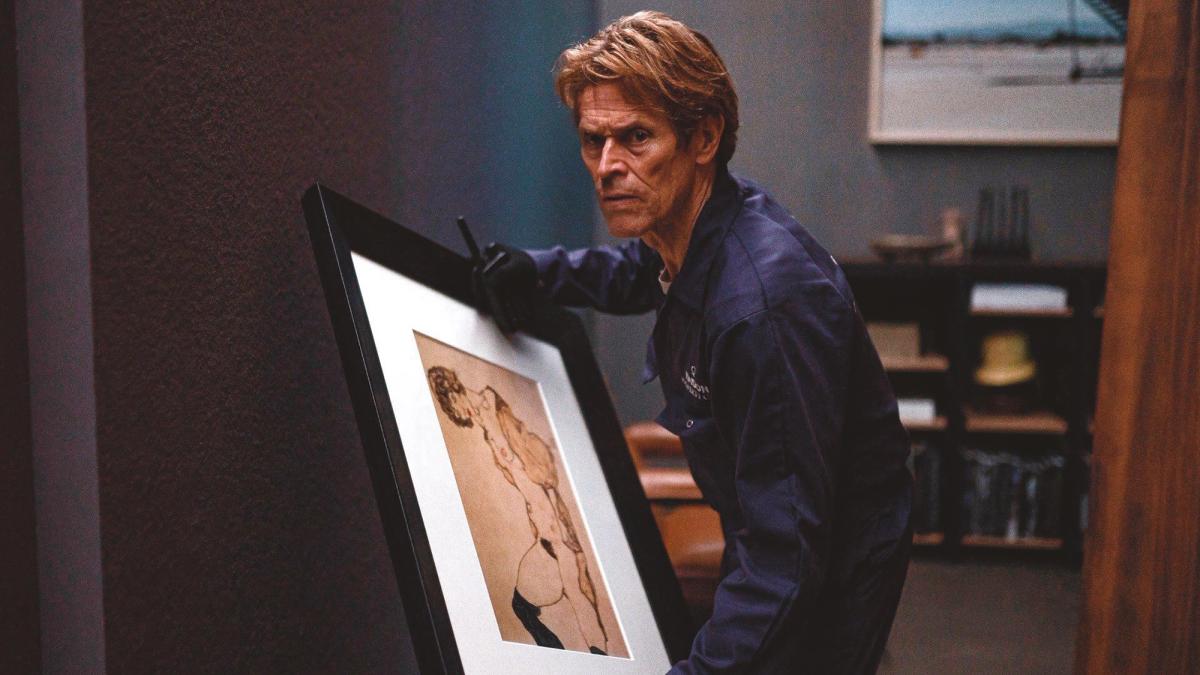The film Inside, which hit US cinemas last week, is an art caper story—a tale built around a crime going wrong.
Here, the US actor Willem Dafoe plays an art burglar for hire in a film that is more of a premise than a story. It is a point of departure for a solo performance by Dafoe, whose character, a burglar named Nemo, is lowered by helicopter into a New York penthouse full of art. The apartment’s owner is said to be in Kazakhstan; his place is filled with objects that are as expensive and generic as the art on the walls: think Architectural Digest. Nemo’s mission is to steal works by the Modern master Egon Schiele.
Forget the age-old starving artist trope—now we have the starving art thief
From the outset, a feeling sets in that this heist is a victimless crime; that a person who owns a flat this luxurious can afford to replace anything stolen from it. Nemo is stuck there when an alarm goes off and seals the doors and windows. That moment turns the trapped criminal into a victim. Forget the age-old starving artist trope—now we have the starving art thief.
Desperate, Nemo searches for a solution to this lost-in-the-arthouse dilemma, damaging or repurposing art as he struggles for a way out, even mimicking (or saluting?) Ai Weiwei with a tower of furniture to breach the skylight. Staying alive takes precedence over all else. You can’t eat a Schiele, or can you? What about the tropical fish in the stylish aquarium? Nemo’s destructive frenzy is perfect fodder for the mainstream target audience that might be sceptical about what constitutes contemporary art these days.
The survivalist fable in the enclosed space unfolds like theatre. In what can feel like an over-extended improvisation with long close-ups, Nemo confronts his solitude, hunger, thirst and extremes of hot and cold when the temperature controls (for the art) go haywire. Losing his mind, Nemo starts drawing on the walls, raising the obvious question about whether art is the ultimate form of insanity. Nemo’s tortured predicament is ambiguous: art is the unaffordable treasure that attracts a thief (and lures us, the audience, as voyeurs), yet it is of no value as Nemo faces dying alone.
Inside is the first feature by Vasilis Katsoupis, who directs television commercials in Greece. The screenplay is by Katsoupis and the British film-maker Ben Hopkins, with the art in the film (actual works by Francesco Clemente, Adrian Paci, Maurizio Cattelan and others) chosen by the Italian curator Leonardo Bigazzi.
Dafoe, who played Jesus in the 1988 epic The Last Temptation of Christ, is more of a John the Baptist character here, stranded in a high-rise desert of luxury. But Dafoe is nothing if not adaptable: in his early 60s, he played a 37-year-old Vincent van Gogh in At Eternity’s Gate (2018), directed by Julian Schnabel. One of his finest roles was in The Florida Project (2017) as the manager of a motel filled with indigent families trapped in the landing path of the airport that serves Disneyworld.
Unexplained plot holes
Katsoupis’s camera captures icy high-rise privilege, with the hard edges of slate and steel and rarefied appliances. As Dafoe scratches away at that veneer, all Katsoupis needs to do is leave the camera on. The minimal script may have more unexplained holes than the furniture that Nemo tears apart, but this is an actor’s film, with Dafoe roaming the set as a man who never met a grimace he did not like. Even for him, it is still a struggle to hold the audience’s interest, locked in a small space with no one but yourself to talk to for 105 minutes.
Inside is an exercise—ultimately a perplexing one that wears thin—for a performer who is game for a challenge. Dafoe will move on to the next tortured character, while we are left wondering how no one in the building heard the deafening noise of a helicopter hovering overhead when Nemo first arrived.


